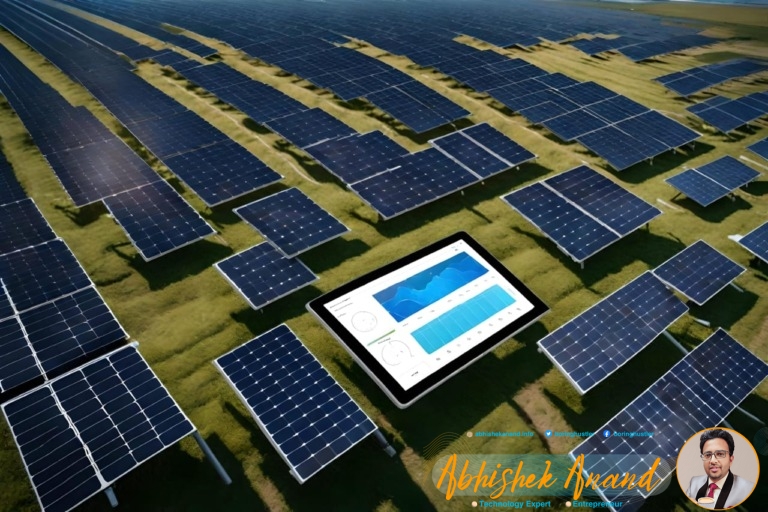As the global demand for energy continues to rise, it is crucial to find sustainable ways of meeting this demand while minimizing environmental impact. Sustainable energy solutions involve optimizing resource management and monitoring energy consumption patterns in real-time. This is where Software as a Service (SaaS) comes into play. SaaS provides a platform that enables businesses to monitor, control, and optimize their energy usage through real-time data analytics.
SaaS solutions are becoming increasingly popular due to their ability to provide businesses with an efficient and cost-effective way of managing their resources. These platforms allow companies to analyze their energy consumption patterns in real-time, providing insights on how they can reduce waste and improve efficiency. By adopting SaaS solutions, companies can make informed decisions about their energy usage by monitoring key performance indicators such as carbon emissions, water usage, and electricity consumption. Additionally, SaaS platforms enable businesses to integrate with Internet of Things (IoT) devices for enhanced automation and data gathering capabilities.
Real-time Data and Analytics
Real-time data and analytics play a critical role in optimizing resource management and monitoring within the sustainable energy sector, allowing for more efficient and effective decision-making processes. By harnessing the power of real-time insights, companies can make proactive decisions that lead to significant improvements in their operations. This is particularly important when it comes to managing renewable energy sources that are often intermittent and unpredictable.
One of the key benefits of using real-time data and analytics is driving efficiency while reducing waste. For example, by gathering information on wind speed and direction, solar radiation levels, and other meteorological factors, renewable energy operators can optimize their equipment settings to maximize output while minimizing downtime. Additionally, real-time monitoring of energy consumption patterns can help identify areas where energy is being wasted or used inefficiently.
Leveraging real-time data to optimize resource management and monitoring in sustainable energy is essential for achieving greater sustainability goals. By using this technology effectively, companies can reduce waste, improve efficiency, save costs, and ultimately contribute towards a cleaner environment. In the next section about monitoring energy consumption patterns without writing ‘step’, we will explore how this process works in more detail.

Monitoring Energy Consumption Patterns
By analyzing and understanding energy consumption patterns, organizations can make data-driven decisions to improve their energy efficiency. Here are four ways that monitoring energy consumption patterns can help identify inefficiencies:
Pinpointing peak usage times: By tracking when energy is used the most, organizations can see if there are any areas where they may be using more energy than necessary. This information can then be used to develop strategies to reduce usage during those peak times.
Identifying equipment inefficiencies: Monitoring equipment usage can reveal which machines are using more energy than others or if some machines are not being used efficiently. This information allows companies to replace or repair inefficient machinery and implement new protocols for equipment use.
Comparing usage across sites: Analyzing consumption data from different locations within an organization can provide insight into which sites need improvement in terms of resource management and conservation efforts.
Predictive maintenance: Utilizing technology such as sensors and machine learning algorithms, organizations can predict when equipment will require maintenance before it breaks down entirely, potentially saving on costly repairs and reducing downtime.
Analyzing energy usage through real-time data monitoring provides valuable insights into how an organization uses its resources. By identifying inefficiencies, businesses can take targeted actions towards reducing overall resource consumption while maintaining the same level of output. The next section will explore ways in which organizations can improve their resource management practices beyond simply monitoring their energy consumption patterns alone.
Improving Resource Management
Improving the efficiency of resource utilization can lead to significant cost savings for organizations. With the increasing demand for sustainable energy, it has become essential to optimize resource management and reduce wastage. SaaS tools can help organizations in achieving this by providing real-time data on resource consumption patterns and automating various processes.
One of the critical aspects of improving resource management is effective resource allocation. SaaS solutions offer advanced analytics that facilitate data-driven decision-making, allowing organizations to allocate resources efficiently. This not only leads to cost savings but also reduces wastage, which is crucial in achieving sustainability goals. For instance, a company using a SaaS solution for its energy management needs can analyze data from IoT devices such as smart meters and HVAC systems to identify areas where energy usage can be optimized.
In addition to efficient resource allocation, SaaS tools can also aid in waste reduction. By monitoring consumption patterns and identifying areas where resources are being wasted or used inefficiently, companies can make changes that result in more sustainable practices. For example, a company using a SaaS solution for water management could detect leaks early on through real-time monitoring and alerts, reducing water waste significantly.
Transitioning into the subsequent section about ‘integration with iot devices’, optimizing resource management through SaaS solutions is just one part of achieving sustainability goals. The next step would involve integrating these solutions with IoT devices such as sensors and smart meters to further enhance data collection capabilities and improve overall efficiencies.
Integration with IoT Devices
Integrating SaaS solutions with IoT devices can be likened to connecting the dots on a canvas, resulting in a more complete picture of resource consumption patterns and enabling organizations to make data-driven decisions towards achieving sustainability goals. With IoT device compatibility, SaaS platforms can access real-time information about energy usage, temperature fluctuations, and other environmental factors that impact energy efficiency. This allows for better monitoring and management of resources, including identifying areas where improvements can be made.
To ensure the successful integration of SaaS solutions with IoT devices, it’s important to address data security concerns. With sensitive information being transmitted between multiple devices and systems, there is an increased risk of cyberattacks or data breaches. Organizations must implement robust security protocols to safeguard against these risks, including encryption measures and access controls.
By integrating SaaS solutions with IoT devices and ensuring their compatibility and security, organizations can benefit from improved resource management capabilities that go beyond simple manual tracking methods. These technologies enable predictive maintenance practices that help identify when equipment needs repairs or replacement before they fail completely. This not only saves money but also reduces waste by preventing premature disposal of assets while optimizing their lifespan for maximum energy efficiency.
Transitioning into the subsequent section about ‘predictive maintenance,’ this capability is critical for companies looking to optimize their operations while minimizing costs and reducing carbon footprints. By leveraging machine learning algorithms that analyze data collected from IoT sensors, organizations gain insights into when machinery will require servicing or replacement based on current performance trends – allowing them to proactively address issues before downtime occurs or costly repairs are needed.
Predictive Maintenance
Predictive maintenance, enabled by machine learning algorithms that analyze data collected from IoT sensors, provides organizations with valuable insights into when machinery will require servicing or replacement based on current performance trends. This allows for preventive maintenance strategies to be implemented, which can reduce downtime and prolong the life of equipment. By identifying potential issues before they become major problems, predictive maintenance also helps to increase efficiency and reduce costs associated with emergency repairs.
Machine learning algorithms play a crucial role in predictive maintenance by analyzing large amounts of real-time data collected from various sources such as sensors and other IoT devices. These algorithms are able to identify patterns and anomalies in the data that can indicate potential equipment failures or other issues. With this information, organizations can take proactive measures to address these issues before they result in unplanned downtime or more significant problems.
Incorporating predictive maintenance into an organization’s energy management strategy can help optimize resource usage and reduce waste. By identifying opportunities for preventative maintenance on critical components of energy systems, companies can proactively address minor issues before they become larger problems that could lead to costly downtime. In the next section, we will explore how saas platforms are being used for energy trading and management to further optimize resource usage across different systems.

Energy Trading and Management
Energy trading and management play a critical role in optimizing the efficiency of energy resources. With the increasing demand for sustainable energy, it has become imperative to develop innovative strategies for managing energy resources efficiently. This subtopic will explore how effective energy trading strategies can be developed to optimize resource management, reduce costs, and increase revenue through data-driven solutions.
Optimizing Energy Trading Strategies
Efficient and profitable energy trading is crucial for achieving sustainable energy goals, and optimizing trading strategies can aid in this endeavor. One key factor in optimizing energy trading strategies is an understanding of energy market trends. This includes knowledge of price fluctuations, supply and demand patterns, geopolitical events affecting the industry, and more. With this information in hand, algorithmic trading strategies can be developed to automate buying and selling decisions based on predetermined criteria.
Algorithmic trading has many benefits over traditional manual methods. These include increased speed, accuracy, and efficiency in executing trades. By leveraging real-time data analysis and machine learning algorithms, traders can react quickly to changes in the market while minimizing risk exposure. Ultimately, efficient energy trading requires a combination of human expertise and technological innovation that allows companies to navigate the complexities of the modern energy landscape while working towards sustainable practices.
Efficiently managing energy resources is another critical component of achieving sustainable energy goals. Without effective resource management practices in place, even optimized trading strategies may fall short of their potential impact on sustainability objectives. Therefore, it is essential to develop comprehensive resource management plans that take into account factors such as renewable vs non-renewable sources of energy, peak usage times throughout the day or year, weather patterns affecting supply chains or production facilities etc., all while considering how these plans will impact overall business operations.
Efficiently Managing Energy Resources
Effective management of energy resources is a critical aspect of achieving sustainability goals in the energy industry. Energy conservation techniques and sustainable energy practices are essential towards optimizing resource management and monitoring, which helps reduce carbon footprint and ultimately, facilitates the transition to a low-carbon economy. One approach to efficiently managing energy resources is through demand-side management (DSM), which involves modifying consumer behavior or load shape patterns to achieve energy efficiency.
To implement DSM effectively, stakeholders need access to real-time data on consumption patterns and system performance. This data can help identify areas where adjustments can be made for optimal performance such as load shifting, demand response, and peak shaving. Moreover, it allows for the development of customized solutions that align with specific business needs while reducing overall energy consumption. Efficient resource management not only reduces costs but also enhances grid stability by reducing the likelihood of blackouts or brownouts thereby increasing reliability for end-users. The next section explores how demand response can further optimize resource management.
Demand Response
Utilizing demand response strategies through SaaS platforms enables the real-time adjustment of energy usage during peak periods to reduce strain on the grid and prevent blackouts. This is achieved through load shedding and peak shaving, which involves reducing energy consumption during high-demand periods by temporarily shutting down non-critical equipment or shifting it to off-peak hours. By doing so, businesses can significantly lower their electricity costs while contributing to a more stable and sustainable energy system.
Demand response programs have proven to be effective in reducing electricity consumption during peak periods. For instance, a study conducted by the Federal Energy Regulatory Commission (FERC) found that demand response reduced peak electricity demand by up to 9% in certain regions of the United States. Moreover, SaaS platforms can also provide valuable insights into energy usage patterns, allowing businesses to optimize their operations and further reduce their environmental footprint.
The integration of renewable energy sources into the power grid has presented new challenges for resource management and monitoring. However, SaaS platforms offer an ideal solution for managing these complexities while ensuring a reliable supply of sustainable energy. By leveraging advanced analytics tools and real-time data streams, businesses can successfully integrate renewable energy sources into their operations while minimizing any negative impacts on the grid’s stability and reliability.

Renewable Energy Integration
Renewable Energy Integration
The successful integration of renewable energy sources into the power grid requires a comprehensive understanding of the complex interactions between different energy systems. This can be achieved through the implementation of advanced data analytics tools that enable businesses to make informed decisions based on real-time data streams. Renewable energy storage and grid integration are two key areas where software-as-a-service (SaaS) solutions play a critical role in optimizing resource management and monitoring.
Renewable energy storage is an integral part of sustainable energy management. SaaS applications can help businesses manage their renewable energy resources by providing them with real-time information on their available capacity, usage patterns, and performance metrics. This allows companies to optimize their use of renewable resources and better plan for times when demand exceeds supply. By doing so, they can reduce wastage, save costs, and improve overall efficiency.
Grid integration is another important area where SaaS solutions are making a significant impact. As more renewable energy sources are added to the grid, it becomes increasingly difficult to manage the complex interactions between different energy systems. Software-based solutions can help businesses monitor power flows across the grid and ensure that there is adequate capacity to meet demand at all times. In addition, these solutions provide visibility into potential bottlenecks or failures in the system, allowing operators to take corrective action before any major disruptions occur.
SaaS applications have a crucial role in driving sustainable energy management by enabling optimized resource management and monitoring. The effective integration of renewables into the power grid requires sophisticated data analytics tools that offer real-time insights into renewable resource availability and performance metrics while ensuring reliable grid operation at all times. Moving forward into carbon accounting, businesses need accurate ways to measure their carbon footprint over time so that they can develop strategies for reducing emissions without compromising operational efficiency or profitability.
Carbon Accounting
Carbon accounting involves tracking carbon emissions and assessing the impact of an organization’s activities on the environment. With increasing concerns about climate change, companies are under pressure to comply with regulations and report their emissions accurately. This subtopic will explore how carbon accounting can help organizations reduce their environmental footprint, achieve sustainability goals, and stay compliant with regulations.
Tracking Carbon Emissions
One potential approach to enhancing sustainable energy management involves tracking carbon emissions through the use of advanced software and data analytics. Carbon offsetting programs are becoming increasingly popular as organizations seek ways to reduce their overall carbon footprint. These programs allow companies to invest in renewable energy projects or other initiatives that reduce greenhouse gas emissions, effectively offsetting their own carbon output.
In addition, sustainability reporting is becoming an important aspect of corporate responsibility. By implementing software that tracks and reports on carbon emissions, companies can provide transparent information about their environmental impact and demonstrate a commitment to sustainable practices. This can help build trust with stakeholders and customers, as well as attract investors who prioritize environmentally responsible investments. As we move into the next section about compliance with regulations, it is important to note that these tracking and reporting tools can also aid in ensuring compliance with local and national regulations regarding carbon emissions.
Compliance with Regulations
Compliance with regulations regarding carbon emissions is crucial for companies to avoid legal penalties and maintain a positive reputation in the industry. As governments worldwide become more stringent in their environmental policies, businesses are facing significant regulatory compliance challenges. Sustainability reporting requirements have become increasingly complex, making it challenging for organizations to track and report their carbon emissions accurately.
To evoke emotion in the audience, here are three sub-lists that highlight the importance of regulatory compliance:
Failure to comply with regulations can result in hefty fines and legal action.
Companies that do not meet sustainability standards risk losing customers who prioritize environmentally-friendly practices.
Non-compliance can also damage a company’s reputation within the industry and among stakeholders.
Given these challenges, many companies are turning to software-as-a-service (SaaS) solutions to streamline their sustainability reporting processes. The next section will explore how SaaS platforms can aid businesses in energy efficiency benchmarking.
Energy Efficiency Benchmarking
Energy efficiency benchmarking is a critical aspect of sustainable energy management that enables organizations to identify opportunities for improvement and compare their performance against industry standards. This process involves measuring and evaluating energy consumption patterns, identifying inefficiencies, and implementing corrective measures to optimize energy use. By benchmarking their energy usage against industry peers, organizations can gain insights into best practices and potential areas for improvement while reducing their carbon footprint and contributing towards sustainability goals.
Identifying Opportunities for Improvement
Identifying potential areas for enhancement in sustainable energy management through the utilization of SaaS technology can facilitate more efficient resource monitoring and allocation, ultimately leading to a reduction in carbon footprint and a more sustainable future. Process optimization is one such area where SaaS technology can play a significant role. By analyzing data from various sources, including smart meters and IoT devices, SaaS platforms can identify inefficiencies in energy consumption patterns and suggest changes that improve overall performance. This data-driven decision-making approach allows for continuous improvement, as new data is collected and analyzed.
In addition to process optimization, SaaS technology can also help identify opportunities for improvement in terms of maintenance practices. By monitoring equipment performance in real-time, these systems can detect anomalies that indicate potential failures or maintenance needs well before they become critical issues. This proactive approach not only reduces downtime but also extends the lifespan of equipment by ensuring timely repairs are made. Overall, identifying potential areas for enhancement through the use of SaaS technology presents numerous benefits to sustainable energy management efforts by optimizing resource allocation and reducing waste while increasing productivity.
Comparing performance with industry standards is another crucial step towards achieving sustainability goals as it provides a benchmark against which progress can be measured. Using relevant metrics such as energy consumption per unit produced or emissions per capita, organizations can assess their current performance levels compared to industry best practices and set achievable targets for improvement. In doing so, companies can hold themselves accountable for their environmental impact while working towards creating a more sustainable future.
Comparing Performance with Industry Standards
An essential aspect of achieving sustainability goals is to measure progress by comparing performance with industry benchmarks. Participating in industry benchmarking initiatives provides organizations with an opportunity to assess their energy consumption, identify areas for improvement, and set realistic targets for reducing their carbon footprint. Benchmarking also enables organizations to track their progress over time and compare their performance against peers in the same sector.
Data analysis plays a key role in benchmarking as it helps organizations understand trends and patterns in energy usage, identify inefficiencies, and develop strategies to optimize resource management. By leveraging data analytics tools provided by SaaS solutions, organizations can gain valuable insights into their energy consumption patterns and identify opportunities for improvement. The use of these tools facilitates the adoption of evidence-based decision-making practices that support sustainability goals. With this information, companies can make informed decisions about energy efficiency improvements that will help them achieve better environmental outcomes while simultaneously improving operational efficiency and reducing costs.
Energy performance contracting represents one such improvement opportunity that companies may consider pursuing after conducting a thorough analysis of their energy usage patterns.
Energy Performance Contracting
Energy Performance Contracting (EPC) is a strategic approach that aims to maximize energy savings and reduce operating costs through the implementation of energy-efficient measures. This approach involves a contractual agreement between an energy service company and a client, where the former provides energy-saving solutions such as building automation systems, lighting upgrades, and HVAC improvements. The main objective of EPC is to optimize resource management and reduce carbon footprint while ensuring cost-effectiveness and sustainable operations.
Maximizing Energy Savings
To optimize resource management and monitoring, a key strategy is to implement SaaS solutions that enable businesses to reduce their energy consumption while maintaining operational efficiency. One approach to achieving this goal is through smart automation, which involves the use of advanced technologies such as sensors, analytics software, and machine learning algorithms to automate energy-intensive processes. For instance, by using smart lighting systems that automatically turn off when no one is in the room or adjusting HVAC settings based on occupancy patterns, businesses can significantly reduce their energy consumption without compromising comfort or convenience.
Another approach to maximizing energy savings is through behavioral changes. This involves educating employees about energy conservation practices and encouraging them to adopt more sustainable behaviors such as turning off devices when not in use or using natural light instead of artificial lighting. By incentivizing employees to take ownership of their personal behavior and making sustainability a core value of the organization’s culture, businesses can achieve long-term reductions in energy consumption. Ultimately, these two approaches can be combined with SaaS solutions to create a comprehensive strategy for reducing operating costs while promoting environmental sustainability.
Reducing Operating Costs
Ironically, reducing operating costs may involve investing in new technologies or equipment that initially appear costly but ultimately result in long-term savings. Implementing automation and exploring new technologies are key ways to reduce operating costs in sustainable energy. Automation can help to optimize resource management by monitoring and controlling energy usage, allowing for more efficient use of resources. This not only reduces operating costs but also minimizes waste and environmental impact.
Exploring new technologies can also lead to significant cost savings. For example, advances in renewable energy technology have made it increasingly affordable for businesses to generate their own clean energy on-site, reducing their reliance on expensive grid electricity. Furthermore, using smart sensors and analytics software can provide valuable insights into energy consumption patterns and identify areas where improvements can be made to further reduce operating costs. By investing in these innovative solutions, companies can achieve significant cost savings while promoting sustainability.
In addition to reducing operating costs, incorporating sustainable practices into building design is an important step towards achieving green building certification.

Green Building Certification
Achieving green building certification requires rigorous compliance with certain environmental standards and practices, which can be facilitated through the use of SaaS solutions for resource management and monitoring. Green building design involves incorporating sustainable construction techniques that minimize energy consumption while maximizing resource efficiency. These techniques include using renewable energy sources such as solar power, implementing water conservation measures, and reducing waste generation.
SaaS solutions provide a centralized platform for managing and monitoring these sustainability initiatives in real-time. By collecting data on energy usage, water consumption, waste generation, and other key metrics, these tools enable facility managers to identify areas where improvements can be made. They also provide insights into how different systems are performing over time so that adjustments can be made to optimize resource usage.
The benefits of achieving green building certification extend beyond reducing operating costs. Certification provides recognition for companies that prioritize sustainability while also enhancing their reputation among customers who value environmentally responsible businesses. In the subsequent section about case studies, we will examine how some organizations have successfully leveraged SaaS solutions to achieve green building certification and reap the benefits of sustainable business practices.
Case Studies
Several companies have successfully implemented green building practices, such as using renewable energy sources and implementing water conservation measures, resulting in reduced carbon footprints and improved sustainability. However, the implementation of these strategies requires careful planning and execution. Case study analysis shows that successful implementation of green building practices involves a combination of factors, including stakeholder engagement, technological innovation, and financial incentives.
One example of a successful case study is the Bullitt Center in Seattle. The building was designed to be self-sufficient in terms of energy usage and includes features such as solar panels, rainwater collection systems, and composting toilets. The design process involved stakeholders from various fields to ensure that the building would meet both environmental goals and practical needs. The Bullitt Center not only achieved LEED Platinum certification but also serves as an inspiration for sustainable building design around the world.
Another example is Interface Inc., a carpet tile manufacturer based in Georgia. In 1994, they launched their Mission Zero program with the goal of achieving zero waste by 2020. They implemented several strategies such as recycling programs for materials like nylon yarns from old carpets to create new products or donating excess materials to nonprofit organizations. By 2016 they had already achieved zero waste to landfill status at all their global manufacturing sites while reducing greenhouse gas emissions by 96%. These examples show how effective implementation strategies can lead to significant improvements in resource management and monitoring within buildings.
Conclusion
SaaS technology has a vital role in the sustainable energy industry, providing real-time data and analytics to optimize resource management and monitoring. By analyzing energy consumption patterns, companies can improve their resource management practices and reduce waste. Integration with IoT devices enables predictive maintenance, ensuring that equipment is operating efficiently and minimizing downtime. Energy efficiency benchmarking allows for constant improvement in reducing overall energy usage, while green building certification provides third-party validation of sustainability efforts.
Case studies have shown that SaaS technology has brought significant benefits to sustainable energy initiatives. One example is a large-scale solar power plant that used real-time data analysis to identify performance issues and optimize energy production. Another case study showed that an office building reduced its annual electricity usage by 23% through implementing smart lighting systems.
SaaS technology offers a powerful solution for sustainable energy management, enabling businesses to monitor their operations more effectively, reduce costs, and minimize environmental impact. As society continues to prioritize sustainability initiatives, the role of SaaS will only continue to grow in importance symbolizing the potential for innovation towards creating a greener future for all.

